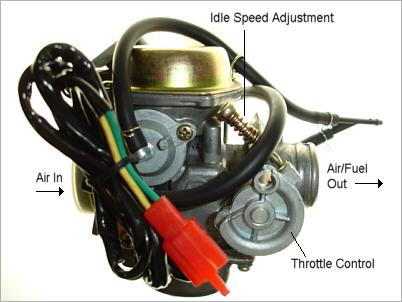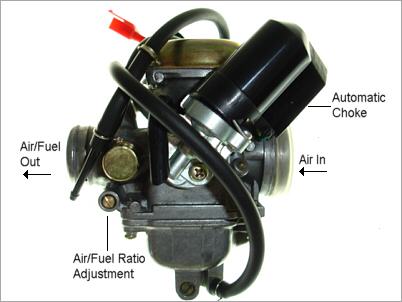Scooter Carburetor Adjustment
If there's any one component that's more likely to go out of adjustment on your scooter (especially perhaps your Chinese scooter!), it's the carburetor. If it does go out of adjustment lots of things can happen. It can make the scooter hard to start, it can make the scooter slow to accelerate, it can cause the scooter to idle badly and stall or it can make the scooter idle fast so that it's trying to go all the time and needs the brake to hold it stationary. None of these things are good.
What the carburetor does is regulate the amount of fuel and air which are supplied to the engine. To go faster you need more fuel and more air and they must be in the right proportion. The fuel also has to be atomized as much as possible (i.e. be supplied in tiny droplets). The carburetor controls all these functions and generally does it quite well.
The type of carburetor used on most 150cc GY6 type engines is a Keihin style CV carburetor with a 24mm throat. Keihin design carburetors are a well tried and tested design developed in Japan (Keihin is a region near Tokyo).
Without removing and disassembling the carburetor, there are only two adjustments you can make, but these should take care of most minor problems. The first is the adjustment of the idle speed.

Above is a picture of a typical GY6 engine carburetor and the view is that from the right side of most engine configurations on 150cc Chinese scooters. There's a small spring loaded screw which adjusts the idle speed. It's right next to the throttle control which is connected to the twist grip on the right handlebar. On most 150cc scooters, idle speed should be around 1500rpm when the engine is fully warmed up. Don't make adjustments when the engine is cold. Take a 5 or 10 minute ride first. When the engine is cold the automatic choke is in operation and that can change the idle speed. If you have a tachometer, setting the speed is easy. If you don't, you want to set the speed to a low idle. Fast enough so that the engine doesn't stumble or stall, but slow enough that the clutch doesn't engage and try to move the scooter forward. On most scooters from 50cc to 250cc, this will be somewhere in the 1500-2000rpm region.
The other adjustment you can make is to the low speed fuel/air ("mixture") ratio. This is done on most scooters using a screw adjustment on the other side of the carburetor as shown below.

This screw changes the air to fuel ratio at low speeds. It shouldn't need much adjustment, but the way to do it is to turn the screw very slightly (1/8th turn) and see if the idle speed goes up or down. If it goes down, turn the screw back 1/8th turn to where it started, then 1/8 turn in the other direction and see if the idle speed goes up or down. If it goes down, turn it back to where you started since you didn't need any adjustment! If the idle speed goes up, continue turning the screw in 1/8th turn steps until the idle speed is at a maximum. If it starts to go down, turn it back to get the maximum idle speed.
You may need to go back to the idle speed screw to lower the idle speed if it's now too fast. So the basic procedure is to set the fuel/air mixture to give you the fastest idle, then use the idle speed adjustment to set the speed to the lowest rpm that gives you smooth running.
If the scooter idles well and runs fine at low speed, but has problems at high speed, the problem may lie inside the carburetor with the main jet. The fuel/air ratio at higher speeds is set by the jets inside the carburetor and to get at them the carburetor has be be removed and disassembled. This can be a tricky job as the parts are small and delicate. The good news is that these carburetors are quite cheap. You can get a new one for $50-$60, so if you can't make your scooter run smoothly and you don't like the idea of taking the carburetor apart, you can always replace it!
Additional Resources